Australia So Much to See


Short version only - full version with pictures yet to come
Tasmania 2006
Preface: This travelogue has been divided roughly into geographic sections. This was not necessarily
the chronological order of the trip as regions visited more than once have been grouped together geographically.
We covered
at first the northern strip as far east as Launceston and the Tamar inlet, and as far west as the coast, then headed down through
the western side of Tasmania. From Queenstown we turned east crossing through the Centre, to visit the Mount Field National
Park and the Gordon River Dam. Then we toured the south eastern section, before heading north along the east coast. After
touring the north east corner, we drove back south through the historic midlands. Next we went up through the mountainous centre
before finishing areas we had missed including around the Western Tiers and the Southern Arthur forests. With only seven weeks
to tour, we had to bypass so many interesting and scenic places.
To be sure we could get into places where parking and
turn around room was unknown and get off the major roads to explore the forest and out of the way places, we sometimes left the caravan
in key locations and took long day trips. Because of the short distances, this is a practical approach.
Getting
a good day to visit Cradle Mountain may not be easy. We chose to go the first clear day. It was easy to drive from Sheffield. Every other day that week the mountain was shrouded with cloud; even though the weather was fine elsewhere.
We reach Tasmania and follow a plan to see a good cross section of the island in our short seven week visit, starting in the North.
We then explored the West, the South, the East, travelled through the historic Midlands and finally toured through the Central
Highlands. See where we camped.

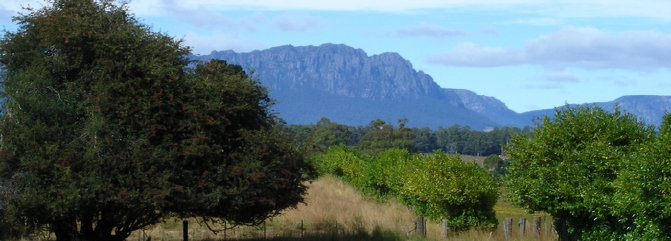
Northern Tasmania
As Tasmania came into view, we passed through a shower of rain, but the evening was fine again when we docked
at Devonport.
We were lucky to have made arrangements to visit fellow caravanners near Sheffield, and soon had made our
home in their paddock looking across to the ever changing moods of magnificent Mount Roland. At a time of year when at home
all is parched and dry and sheep are reliant on being fed hay and grain, the paddock where we were parked had just been mown for the
second time since November and all the sheds were near full of hay. Parked alongside a hedge of laurel bushes, it was a very
‘English’ environment. Beautiful fresh water was pumped from the small river running through their property, and our hosts introduced
us to wonderful fresh Tasmanian vegetables from their garden.
Sheffield is a charming town with murals on walls of most of the
businesses. This has generated a tourism boom in this small town close to the mountains.
At Lake Barrington, there is a world class rowing venue on the large long dam which creates the lake.
Nearby is Tazmazia
– with a maze made of hedges, a lavender farm and a pancake restaurant. Try if you can to eat the entire”Pig Out Special”, a
rich feast of layered pancakes slathered with volumes of fresh cream.
Taking advantage of a forecast clear day, we went to Cradle
Mountain. We took the walk around Dove Lake, with reflections of the famous cradle in the lake. A variety of mountain
flowers, trees and shrubs are around the edge. This area receives 2.5 metres of rain, mostly in winter, and water oozed
out of the hills into the lake.
Heading to the mountains
from Sheffield, we passed Mount Roland, Mount Claude and Mount Vandyke shrouded in early morning mists on our way to the central highlands. Across the road, a quaint dairy made of roughly hewn logs tied together, has a mural of cows coming in for milking on the side.
Not far from the park on a former farm is a set of stockyards complete with loading ramp made of logs. A huge stump remains
as the main trunk of the log lies where it was felled.
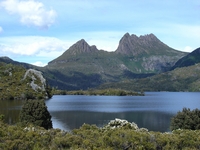
Opium poppies are grown under licence and strict conditions in the north and central agricultural areas of Tasmania. There are
large “Danger: Keep Out” signs on the fences of the poppy crops. The lucrative poppy industry was commenced in Tasmania in the
late 1960s by the pharmaceutical company Macfarlan Smith; a subsidiary of Glaxo. Tasmania is the world's largest producer of
opium alkaloids for the pharmaceutical market. The industry is highly efficient producing about 50% of the world's concentrated
poppy straw for morphine and related opiates from 10.7% of the world production area. Concentrated poppy straw is actually the
extracted opiates crystallized out of solution, rather than from the poppy heads where opium is extracted as latex from the heads
before they dry. Growing poppies for poppy straw and using an extraction process which bypasses the opium stage further insures
against leakage of opiate raw materials into the illicit market. The seeds contain no significant amount of alkaloids and are
sold for culinary purposes.
Near Wilmot, an amazing vista shows the peaks of many mountains of the central highlands. We had been lucky to have such fine weather at Cradle Mountain the previous day as on this occasion, the Cradle peaks were obscured
by cloud. Cloud is also covering the top of Mount Roland. Lake Barrington can also be seen from this magnificent vista
lookout point.
At Lillico Beach Reserve near Devonport, Little (Fairy) Penguins nest. The adults come in each night
to feed their chicks which are hidden in burrows in the small sand dunes. Park Rangers attend, give talks and hand out information
sheets at no charge although donations are welcome. We watched the sun set through shade of gold through to darkness, but on
a low tide and with the danger of predation on a moonlight night, the penguin parents were late arriving. Fat chicks, now fully
feathered and almost ready to leave their nests came out of the burrows squawking anxiously waiting to be fed. It was very late
by the time the first penguin waddled the long distance across the tidal flats and up the beach to climb the sand hill to its chick.
Lush
green vegetables crops, rich red soils and golden grain crops near Devonport.
Railton is the home of a large cement works
and is famous for ‘topiary’ (shaped shrubs). Here is a lion in the Lion’s park, opposite a mural on the grocery store wall.
Not far downstream from Latrobe, the river Mersey opens into wide and long estuary which forms the port at Devonport. Opposite the river in Latrobe is the Axeman’s Hall of Fame. Anyone who has enjoyed watching log chopping as a sport will be
able to spend the greater part of a day there.
At beautiful Gunns Plains (a special favourite of ours), a small wildlife
park on the Leven River features local and imported fauna. I just loved these small Indonesian buffalo. A young Tasmanian
Devil gets defensive. We did not see any Tasmanian Devils in the wild.
The valley of Gunns Plains
is surrounded by mountains, with the Leven River trickling through and providing water for irrigation. The area is rich with
caves, and we enjoyed the tour of the cave which is open to the public. It does have a lot of steps as we went down fifty metres.
A Tasmanian woodpile. Where ever we went, people had fence lines lined with chopped fire wood.
A short walk
through a tree fern filled rain forest comes to an abrupt end overlooking the 120 metre deep Leven Canyon, with the headwaters of
the Leven River way down below. Rivers in the north are small and clear as the water rushes over a clean pebble beds.
On the Table Cape Peninsula, we looked across a colourful scene of irrigated vegetable crops and a tulip farm. Looking
towards Boat Harbour from the Peninsula.
Fossilised shells of different ages on the beach at Fossil Bluff near the delightful coastal town of Wynyard. Fossils here have
been dated at 22 million years old.
Looking inland on a rural road near Yolle; one we took while getting away from the highway
and exploring as we zig-zagged our way along the North of the Island, gradually heading West and taking in different sights each day.
Inland from Burnie near Upper Natone a local told us about the horse shoe shaped Lake Kara which was a lovely peaceful lunch stop
and well off the regular tourist routes. I saw a black tiger snake hasten into the reeds at the waters edge as I walked by.
At Dip Falls we went down the steps to the base of the falls, which tumble over
several levels of brick-like rocks. Back at the top, I walked out across the slippery top of the falls to nervously look down. Quite an experience.
The charming old town of Stanley and the track to the top of The Nut – we took the chairlift.
View
of the harbour and isthmus from The Nut at Stanley.
The view coming down – as I shut my eyes and held on to the chairlift
hand rail tightly. Well, to be honest, the view across Stanley as we got to the edge of the drop was amazing, and my camera memory
card chose that very moment to be full. Try as I did, I could not change the card while hanging on tightly with both hands.
At Port Latta on the coast near Stanley, iron ore is pelletised ready for export. It comes from the mines at Savage River through
95 kilometres of pipeline in the form of a slurry of iron ore mixed with water. The pellets are loaded onto ships at the end
of a 1.6 km conveyor belt.
Heading inland from Stanley, we had lunch by the roadside in a farming area, enjoying
views to the north coast. We looked over the islands and tidal flats to the north, and glimpsed The Nut at Stanley almost hidden
beyond a copse of trees.
At Robbins Crossing, cattle are taken across to graze on Robbins Island at low tide. At nearby
Montagu we spoke to people launching boats to go fishing and mutton birding out at the islands. Mutton birds are the young
of the shearwater, and are pulled from their burrows as a highly sought food. Mutton birders have an annual bag limit of 100.
The
sea was rough, and rain was closing in when we reached the rugged west coast at Green Point near Marrawah. Mount Cameron West
dominates to the north.
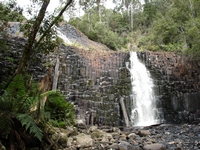
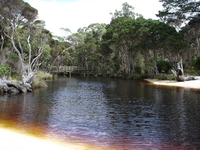
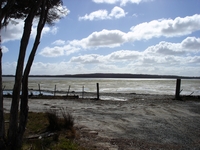
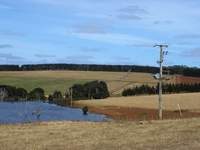
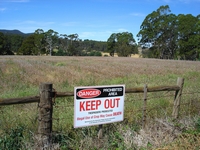
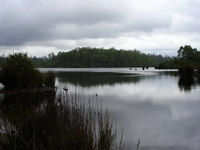
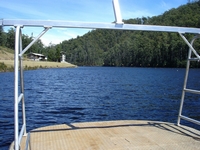
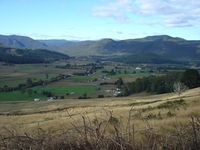
Copyright (C) 2013 AustraliaSoMuchtoSee.com. All rights reserved












